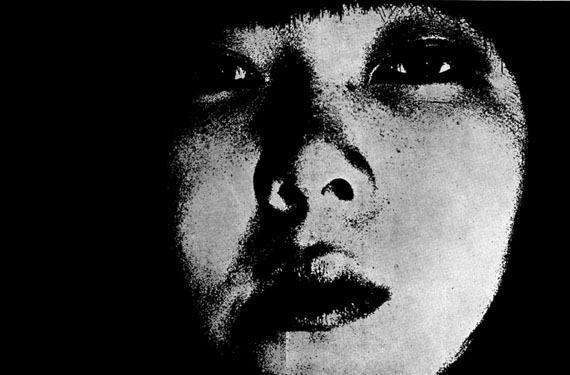
PROVOKE. Between Protest and Performance
Photography in Japan 1960/1975
Nobuyoshi Araki » Koji Enokura » Akasegawa Genpei » Eikoh Hosoe » Takamatsu Jiro » Daidō Moriyama » Shômei Tômatsu » Okada Takahiko » Yutaka Takanashi » Yosuke Taki » Nakahira Takuma » & others
Exhibition: 14 Sep – 11 Dec 2016

LE BAL
6, Impasse de la Défense
75018 Paris
+33 (0)1-44707550
contact@le-bal.fr
www.le-bal.fr
Wed 12-20, Thu-Sun 12-19

Private collection
"PROVOKE. BETWEEN PROTEST AND PERFORMANCE"
PHOTOGRAPHY IN JAPAN 1960 - 1975
Exhibition: 14 September – 11 December, 2016
Opening: Wednesday, 14 September,
LE BAL presents the first exhibition dedicated to the famous Japanese magazine, which greatly influenced the history of photography through
its major figures: Nakahira Takuma, Moriyama Daidō, Takanashi Yutaka. Both a manifesto and a collective work, Provoke assigned a new role to photography as a reaction to violent social and political turmoil and echoed the emerging Performance art scene.
The exhibition and the accompanying book are the result of three years of research and collaboration between four international museums – Albertina (Austria), Winterthur Fotomuseum (Switzerland), the Art Institute of Chicago (USA) and LE BAL (France) – and more than 40 international lenders, artists, collectors, museums, and galleries
Part I : Protest
Beginning around 1960, a wave of books appeared in conjunction with the country’s first large-scale protests, mobilized against the 1960 renewal
of the United States-Japan alliance. The protest movements, many student-led, grew in the later 1960s, at which point they generated a torrent of photobooks and photographic prints. Many of these books featured innovative graphic design involving photography: serialized imagery, gripping
text-image combinations, dynamic cropping, and an alternation of provocatively “poor” materials (rough paper, low-resolution printing) with
gatefolds and odd trim sizes.
During the years around Provoke, the massively creative protest movement created a riveting photoworld of opposition to corporate malfeasance and the despotism of the neoliberal Japanese state. The members of Provoke - critic Taki Kōji, poet Takahiko Okada, critic/photographer Takuma
Nakahira, and photographers Yutaka Takanashi and Moriyama Daidō - claimed that protest photography was exhausted, and asserted the impossibility of effecting lasting change through direct political action.
Nevertheless, their writing and images are suffused with the tactics developed in Japanese protest photography, as this exhibition will show; they and their colleagues also expressed real sympathy for the protesters as the movement reached its culminating period in 1969-71.
Part II : PROVOKE - the magazine
Provoke took place "between protest and performance". It 'brought up for discussion' both the state and its dissenting subjects. The magazine (like the protesters) showed dissatisfaction with consumer capitalism, a society saturated by mass media, and the uncontrolled transformation of urban space, but it also subjected the group dynamics of protest movements - the formation of a community of discussants - to a radical critique, along the lines of
the architectural collective Metabolism, the performance group Hi-Red Center, or Terayama Shuji’s Tenjo Sajiki troupe. Its members responded to the precedents set by photographer Tōmatsu Shōmei, as regards the relation of photography to language, and the need to question the subject position of anyone engaged in ‘reporting’ on the times. In magazine and book projects that stretch over roughly a decade - far longer than the quick life of Provoke itself - members of the group acted to take apart subjectivity and to keep photography, and language, in a state of perpetual development: words and images in formation, engaging yet resisting a world dominated by information.
�

Part III : PERFORMANCE
To go beyond mere picturing, photography would need to forsake its claim to be a lasting record, a "mirror with a memory." Instead, photographs
and photobooks would become fleeting, contingent things, flaring up into the social landscape.
Moriyama Daidō, Nakahira Takuma, and Araki Nobuyoshi are among the photographers who became intensely interested around 1970 in making
darkroom activity or other processes of print creation into a visible and active part of photographic creation. They were preceded in these
interests by dance performers, such as Hijikata Tatsumi and Terayama Shuji, who had worked with filmmakers and photographers; and by groups
such as Hi-Red Center, who blurred the line between photodocumentation and live works involving photography among other media.
Architect Arata Isozaki had also importantly used a photosculpture as a site of live intervention for an exhibition in 1962. But the influence did
not flow one-way only.
In the early 1970s, following Provoke, Takamatsu Jiro, a member of Hi-Red Center, and Kōji Enokura, who had belonged to the related fine-arts
group Mono-Ha, each turned to photoconceptual art expressly after witnessing the work of Provoke photographers.
Publication
To coincide with the exhibition, LE BAL and Steidl copublish "Provoke – Between Protest and Performance". The book retraces the history of the short-lived—but cult—avant-garde Japanese photography magazine Provoke. It reproduces the complete photographic works and critical writings showcased in the three issues by its members Taki Kōji, Okada Takahiko, Nakahira Takuma, Takanashi Yutaka, and Moriyama Daidō. Positioning "Provoke" within a socio-historical context of major political upheaval, the book analyzes the influence and legacy of this powerful group that broke the boundaries between protest, photography and the performative arts in Japan. The book features full reprints of the three Provoke issues, students' "Protest books", important theoretical texts of the period translated from Japanese for the first time, works from major performative artists/groups and interviews with Moriyama Daidō, Araki Nobuyoshi, and Hosoe Eikō, as well as previously unpublished critical and curatorial essays.
Edited by Diane Dufour and Matthew Witkovsky, with Duncan Forbes and Walter Moser
Book design by Pierre Hourquet
800 pages
7.5 x 9.8 in. / 19 x 25 cm
600 black-and-white photographs
Tritone
Paperback
60 €
�

